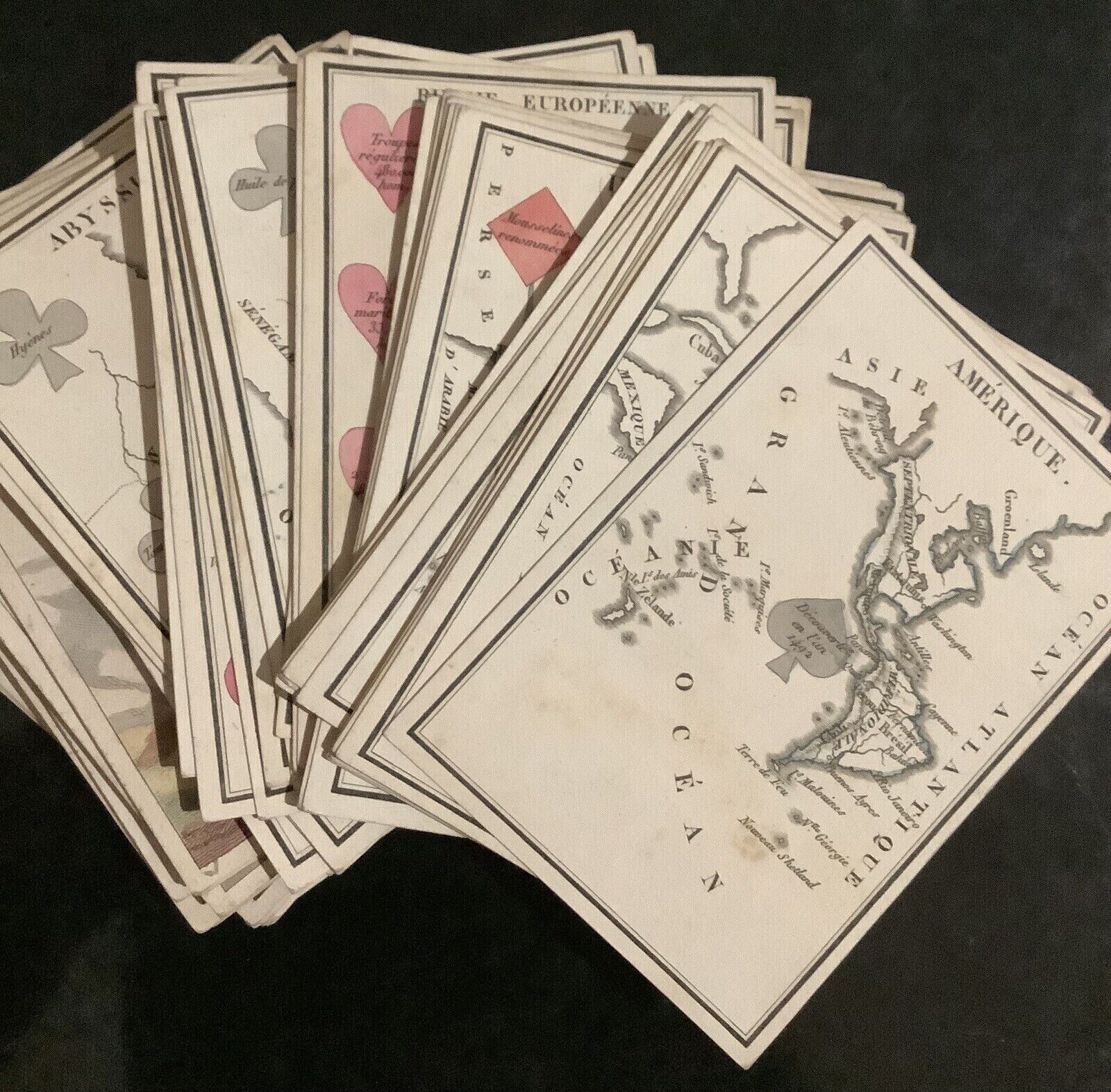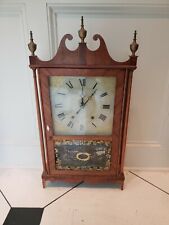c 1825 Geographical Playing cards - attributed to René Janet

When you click on links to various merchants on this site and make a purchase, this can result in this site earning a commission. Affiliate programs and affiliations include, but are not limited to, the eBay Partner Network.
c 1825 Geographical Playing cards - attributed to René Janet:
$6500.00
Very rare deck of French-suited cards, in fact a small atlas that describes the world through the game and illustrates it with geographical maps engraved in copper and hand-watercoloured.The cartouche, also engraved in copper and applied to the case, shows the title "MAPPE-MONDE" on a world map supported by an allegorical figure.Printed in France probably in the 1820s.- Technique: engraving on mask-painted metal with hand finishing; White back- Condition: good with traces of wear and burnishing. Look at the images carefully- n 52 cards: complete- Card size: 74x106 mm- Manufacturer: attributable to René Janet for comparison *(1)*(1) In the "Bibliographie de la France" a card game entitled "Boston de l'univers, ou Jeu des quatre parties du Monde" printed in Paris by René Janet in 1824 is cited / described in "Geschichte auf Spielkarten, 1789 -1871" Hoffmann - Dietrich, 1987, Stuttgart (cat. no. 158) / preserved in the Cary Collection of Playing Cards (cat. FRA 266) which however omits the author and dates it 1810c.
René Pierre Janet (1779-1840 Paris), cartier du Roi, rue des Mathurins Saint Jacques n.10 in Paris; he marries the eldest daughter of Charles Richomme, also a soft-cut printer and engraver, active in Paris like his ancestors.------The suits of the deck of playing cards, hearts, diamonds, clubs and spades represent four continents, respectively: Europe, Asia, Africa and America.The numerals are geographical maps, where the axes represent the continents and the other maps depict the various most significant countries, arranged in ascending order according to their importance. Captions indicating various national characteristics are engraved on the seed marks. The order of the countries according to the value of the cards as well as their captions and the titles present on the honors express judgments that are certainly not free from parochialism.Hearts: Europe; Netherlands; Prussia; Türkiye; Italy; Spain; Austria; England; European Russia; France.Paintings: Asia; Japan; Tibet; Independent Tartary; Arabia; Asian Türkiye; Siberia; Hindustan; Persia; China.Flowers: Africa; Canary Islands; Sudan; Sahara; Guinea; Congo; Abyssinia; Empire of Morocco; Berber coast; Egypt.Spades: America; Colombia; Buenos Aires; Chile; Brazil; Peru; Guyana; Mexico; Canada; United States.
The court papers present illustrious characters, some who actually existed, others I believe to be fictional.
Hearts: Europe is represented by the French Francis I (Re-Loyautè); Catherine II of Russia (Queen-Puissance); I was unable to identify the Infantryman (Politique): it seems to depict a halberdier, a man-at-arms in the Italian Renaissance style.Paintings: Asia is represented by the Chinese emperor Qianlong (King-Justice); the Queen (Luxe) depicts Statira the consort of the Persian king Artaxerxes II or perhaps Statira II the second wife of Alexander the Great; the Infantryman (Faiblesse) is Hyder Ali, sultan and Indian soldier of the Kingdom of Mysore, in southern India.Clubs: Africa is represented by Saladin, sultan of Egypt (Re-Férocité); the Queen (Despotisme) is Zulema of Algiers, from J.Dryden's drama "The Conquest of Granada by the Spaniards"; the Knave is a Moroccan Moroccan (Indolence) who smokes a long hashish pipe;Spades: America is represented by US President George Washington (Indépendance) holding the Declaration; the Canadian Neala (Queen-Aservissement) breastfeeds her baby in complete naturalness; for Mexico Telasco of the Apache people (Fante-Liberté)----Soon, in 1827, these cards were copied in England by Charles Hodges (27 Portman Street, Portman Square, London) who revived them under the title "New Royal Playing Cards". The English version was more successful and is therefore better known and more widespread than the original: it was also proposed in copperplate with very similar designs, but introducing some variations. The position of France and the British Isles are reversed compared to Janet's sequence and among the court cards of the sign of hearts the king is replaced with George IV and the knave with Robespierre. Finally, the captions on the suits disappear: the deck is however accompanied by an explanatory booklet ("A Brief Explanation of the Countries").The same game was reprinted in 1839 by William and Henry Rock under the title "The New Geographical Cards" or "Court Game of Geography".
c 1825 Geographical Playing cards - attributed to René Janet:
$6500.00

Related Items:
c 1825 Geographical Playing cards - attributed to René Janet
$6500.00
C.1825 John Vick of Stroud Georgian Grandfather Moonphase Longcase Clock
$2450.00
Antique c1825 Chauncy Ives Pillar & Scroll Shelf Clock RARE All Original
$1359.00







